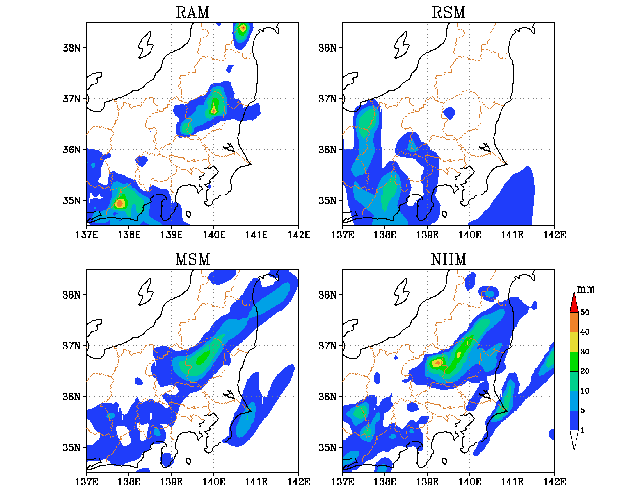Kanto Area Meso-analysis Experiment and Forecast Experiment with
a Nonhydrostatic Model
K. Saito*,1, H. Goda2, K. Yamada2 and T. Tsuyuki2
1Meteorological Research Institute
2Numerical Prediction Division
Japan Meteorological Agency
Kanto Area Meso-analysis Experiment (KAMEX; Tsuyuki et al. 1999) is a research project conducted by the Japan Meteorological Agency (JMA) and its belonging
organizations including the Meteorological Research Institute (MRI). The aim is
to confirm the benefit of new observational data in mesoscale numerical predictions and to develop a mesoscale 4-dimensional data assimilation system for disaster prevention and aviational forecast.
Four heavy rain cases were selected from 1997 summer season, and assimilation experiments with an hourly analysis cycle using the JMA's 10 km hydrostatic mesoscale spectral model (MSM) was conducted. In this MSM's analysis cycle, in addition to the conventional data, wind data from Doppler radars, wind profilers, ACARS and the ERS-2 microwave scatterometer, precipitable water content data from
the GPS ground receiver network and SSM/I, and temperature data from ACARS were
assimilated by the optimum interpolation method. The radar-AMeDAS rainfall estimation and TBB data from the GMS-5 satellite were used in the physical initialization (Yamada et al. 1998). An observation system experiment (OSE) was conducted to see the effect of each observational data (Goda and Yamada 1999).
Forecast experiments of the KAMEX cases with the MRI Mesoscale Nonhydrostatic
Model (NHM; Saito 1997; Saito and Kato 1999; http://www.mri-jma.go.jp/Dep/fo/mrinpd/INDEXE.htm) were also conducted using the MSM's analysis data.
Figure 1 shows the observed rainfall from 1500 UTC to 1800 UTC 28 July 1997 and corresponding 3 hr accumulated rainfall by three numerical experiments starting from initial conditions at 1200 UTC 28 July. Heavy rainfall exceeding 50 mm was observed at northern Kanto (central part of the main island of Japan; Fig. 1a). However, it was not predicted with the JMA's 20 km operational model (RSM) using the operational 12-hour analysis cycle and the conventional data only (Fig. 1b). By the virtue of the one-hour interval assimilation of the mesoscale observational data and a higher resolution, MSM successfully reproduced the rainfall (Fig. 1c), though the maximum intensity was only half of the observation. The 10 km NHM starting from the MSM's analysis gave further improved rainfall intensity (Fig. 1d).
 Fig. 1: a) Radar-AMeDAS analyzed rainfall from 1500 UTC to 1800 UTC 28 July 1997. b) Corresponding 3 hr accumulated rainfall amount by RSM with the operational analysis. c) Same as in b), but by MSM with the MSM analysis. d) Same as in c), but by NHM.
Fig. 1: a) Radar-AMeDAS analyzed rainfall from 1500 UTC to 1800 UTC 28 July 1997. b) Corresponding 3 hr accumulated rainfall amount by RSM with the operational analysis. c) Same as in b), but by MSM with the MSM analysis. d) Same as in c), but by NHM.
Result of the OSE shows the ACARS and wind profiler data have primary impact
to improve the forecast of the rainfall in this case. Sensitivity tests suggest
that inclusion of ice phase and higher resolution improves the forecast of NHM,
while NHM shows predictions similar to MSM when the convective adjustment is employed instead of the explicit cloud physics.
References
-
Goda, H. and K. Yamada, 1999; Kanto Area Meso-analysis Experiment: Observing
System Wxperiment (OSE). Proceeding of Conference of Meteor. Soc. Japan, 75, A156 (in Japanese).
-
Saito, K., 1997; Semi-implicit fully compressible version of the MRI mesoscale nonhydrostatic model - Forecast experiment of the 6 August 1993 Kagoshima torrential rain. Geophys. Mag. Ser. 2, 2, 109-137.
-
Saito, K., and T. Kato, 1999: The MRI mesoscale nonhydrostatic model. Met. Res. Note, 196, 169-195 (in Japanese).
-
Tsuyuki, T., and Coauthors, 1999: The Kanto Area Meso-analysis Experiment. JMA Technical Report, No. 120, 174pp (in Japanese).
-
Yamada, K., and Group of KAMEX, 1998; Kanto Area Meso-analysis Experiment: Assimilation and Forecast experiment with JMA 10 km model. Proceeding of Conference of Meteor. Soc. Japan, 74, B204 (in Japanese).
*Corresponding author address:
Dr. Kazuo Saito
Meteorological Research Institute
1-1 Nagamine, Tsukuba, Ibaraki 305-0052, Japan
E-mail: ksaito@mri-jma.go.jp
